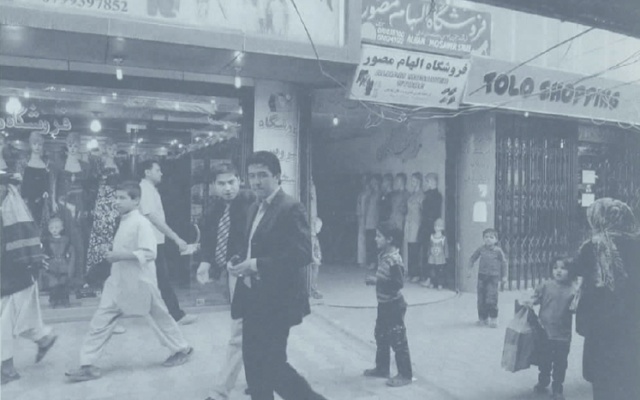First published in A Few Questions Regarding the Hesitance at Choosing between Bringing a Bottle of Wine or a Bouquet of Flowers // 100 Notes, 100 Thoughts: Documenta Series 026 2012. Reprinted here courtesy of the Author and documenta 13.
1.
Sometime in 1971, Harald Szeemann visited Turin in preparation for the Documenta exhibition he was curating for the following year. Among the people he tried to meet in the city was Alighiero Boetti, but when Szeemann visited Boetti’s studio, the Italian artist wasn’t there. All indications are that somebody took the curator through the studio and showed him around, and that, mistakenly, Szeemann forgot a small piece of paper with a list of artists’ names. Several weeks might have passed before Boetti returned to Turin (that year he took two long trips to Afghanistan) and found the piece of paper in his studio. To his surprise, there was a question mark next to his name.
It can be deduced from the correspondence that followed the incident that Boetti misinterpreted Szeemann’s notes. During their epistolary exchange, the artist confronted the curator and the misunderstanding was corrected: the question mark next to the artist’s name didn’t have to do with doubts about his work or about its inclusion in the exhibition. However, it was only then that the discussion about Boetti’s participatory in Documenta 5 really began.
If Szeemann’s early curatorial strategies for Documenta were surrounded by debate,1 it is assumed today that when one is asked to participate in an exhibition, what one is actually expected to do is to temporally inhabit a specific work frame, and the host – the one who extends the invitation – also becomes a sort of caretaker. For this notebook, I will try to invite you, dear reader, to become the guest of my own thoughts and questions, those that emerge as I find myself thinking about dOCUMENTA (13). These have mainly to do with the different layers implied by inhabiting a present context, and with how easily a guest, in situations like this, could turn into a host. In other words, they have to do with the negotiations between intention and generosity.
When one is invited for, say, dinner or to spend the night at someone’s house, one might need to choose between bringing a bottle of wine or a bouquet of flowers; or, in a more determined gesture, one could decide to accept the invitation by entering the back door and helping in the kitchen. When an invitation is accepted, there are innumerable ways one can react and behave: one could easily dwell on what one assumes the host is expecting from the guest; or one could go so far as to take over the space – to mention two opposite cases. The same could happen in an exhibition. Some might say it is possible to take shelter in a framework, in a statement; or one could occupy someone else’s space, personalize it as much as possible, and then let the curatorial statement continue on its path. There is also the most haunting possibility of all: being unable to affect the discourse. Such a result, or rather, lack of result, would render one’s nature as a guest harmless. Furthermore, one might as well not accept an invitation or, even more significantly, have the invitation be withdrawn from you. But probably the most radical way to impact a situation like this would be to accept the invitation and then walk away from it, by suddenly quitting the status of a guest. But ideally, or most of the time, as one accepts invitation one can hope to slightly transform a situation, to bring something to it, in the most refined way, by simply spending time in it, by being oneself in it. There are a many possibilities of achieving this as there are ways to extend an invitation, and sometimes things might get even a little more complicated. The way invitations are made the ways of reacting to them and thereby developing a relationship, deserve, under this light, a closer look, all the more so in a case like this one, when the one who writes has been obsessed with artists and their relationship to hosting.
The correspondence between Szeemann and Boetti is short but nevertheless very telling.2 It’s clear, for example, that several works were suggested and considered before a final agreement was reached. By looking closer at the different works Boetti suggested for the show, one could draw a number of conclusions as to how the artist wanted to react to such an invitation.3
The work by Boetti that was mainly under discussion for his participation in documenta 5 was at the time called L’arazzo – the first embroidered world map that the Italian artist conceived and created in Afghanistan. It was dated precisely the year in which Szeemann visited Turin. The 1971 Mappa, as it was later titled, only arrived in Europe in the spring of 1972, probably a bit late for the exhibition and likely the reason other works by the artist were considered. In the end, a different work was exhibited, but the fact that Mappa was the work reproduced in the catalogue suggests that it might still have been shown, which makes things in this relationship more interesting. However, the work that was without doubt displayed, and which in not mentioned in the available correspondence, is Lavoro postale (permutazione) (1972).4
Without drawing conclusions yet, it is important to mention that one more work was considered. In early 1972, Boetti returned to an apparently previously discussed idea (“Ritorno, quindi, all’idea prima,” he wrote to Szeemann): to do a very small intervention in the exhibition. Boetti wanted to make a brass plaque with his name on it and planned to place it at the entrance of the Museum Fridericianum.5
Is a strategy such as Boetti’s a way of learning how to react to an invitation? How long does it take to understand one’s own relationship to it? Is it possible to negotiate one’s position and at the same time to attempt to play the expected role of the guest? Is there a way to break with expectation? How much can the concept of “the guest” be expanded in a situation like this one? Are those hypothetical attitudes of the guest a continuation of the original invitation? Is an invitation real before the event? Does one destroy an invitation by publicly analyzing it?
Boetti’s last proposal was never executed, but a number of things can be deduced from his initiative. By repositioning his name at the entrance of the main venue of documenta 5, it is as if he were looking at reframing the exhibition with his own hospitality and at an extending his own invitation to enter the show. Maybe, once inside the work, guests would realize that the artist has changed the rules of the game, becoming a host of the exhibition by welcoming them as visitors.
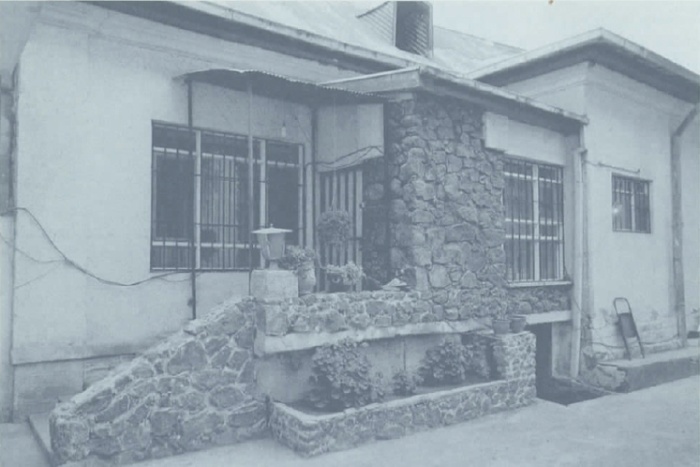
Bungalow w kabulskiej dzielnicy Shar-e Naw, w którym działał Hotel Jeden, 2010.
2.
Artists who have engaged in hosting activities have drawn my interest for some time. I’ve dwelled in those places, first through other people’s accounts, memories, and descriptions, then by returning to those sites while visiting them for the first time. This is how my curiosity led me to Boetti and the One Hotel in Kabul, and to speculate on what had happened in the small house that hosted the initiative long before I could actually make it to Afghanistan.
That same motivation brought me to St. Croix in the U.S. Virgin Islands in 2005, where artist Daniel Buren had made an early intervention in a beach resort, the Grapetree Bay. When I visited the place that summer, I was too late to experience Buren’s work as he had seen it finished, and also too late to check in to the resort. Sixteen years before, in September 1989, Hurricane Hugo had hit the island and left the hotel and some of Buren’s work half-destroyed. The hurricane was the last blow to an enterprise that was never economically successful, and the owners finally closed it. The works were left to their own faith and little by little were taken by nature. When I found them, undergrowth had climbed over the building, dramatically changing the context that gave asylum and meaning to the first in situ works of the French artist.
Fairleigh Dickinson Jr. and Thibaut de Saint Phalle commissioned Buren to make these early mosaic works, which he embedded into the construction, in 1965. They decorated the place while the site hosted them. One could argue that the Grapetree Bay must have provided good times for its guests as, even years after the catastrophe, patrons were often seen returning to the abandoned hotel, walking through the debris as they remembered better times. This is what one can hope for an artwork, I thought, as I tried to uncover the murals: that it outlives its context, or even re-signifies it, as Buren’s work seem to have out lived their hosting site.
Coincidentally, seven years later, in a text that started his disagreement with Szeemann’s documenta, Buren – who was also invited to participate in the exhibition – referred to the confinement of art in an exhibition context as a place where art could live, be preserved, and therefore die: “Thus, the limits art has created for itself, as shelter, turn against it by imitating it, and the refuge that the limits of art had constituted are revealed as its justification, reality, and tomb.”6
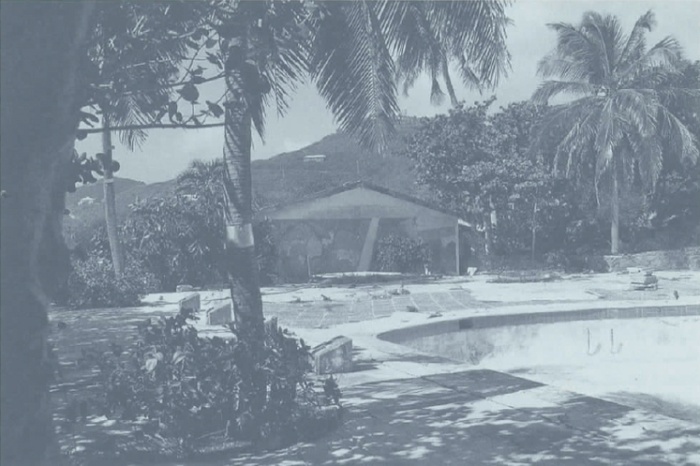
Daniel Buren, Mozaika, 1965, praca site-specific, Zatoka Grapetree, St. Croix, Wyspy Dziewicze, 2005.
By the end of the 1960s, the idea of the artist as a host was further developed, as artists took the task of actually becoming hoteliers. Almost without acknowledging the fact that I was too late to be a guest, in 2004 I approached the house on 7175 Sunset Boulevard in Los Angeles, knowing that in 1968 Allen Ruppersberg had installed there a well-known project, Al’s Grand Hotel. On weekends, for three months, the artist hosted people in seven rooms. Each room was decorated differently, and a certain cinematic narrative ran through the lodge. The rooms somehow flirted with specific moments of the artist’s personal story, and visitors were expected to share their own imaginings and to add to the larger novella that the hotel was. For Ruppersberg, hosting was more that taking care of his visitors; he invited the public to adhere to the space, to the work of art. How did Ruppersberg take care of his guests beyond those walls? What did he expect from them? Did this experience have a further influence on his work? Did he see himself as a host in other works that dealt with similar issues in a less direct way?7
Can an artist become, in turn, an iconic hotel guest? By constantly returning to the issues that occupy my time these days, one ends up inverting the question. For documenta 5, Ruppersberg proposed to exhibit a project that displayed a certain subjectivity and could give a glance at an artist becoming a guest. A review of the correspondence with Harald Szeemann indicates that at least in one of the workd proposed to be shown in Kassel, the North American artist displayed transcripts of dialogues he had conducted in motels while traveling through the United States.8 Nevertheless, a certain idea of a hotel guest can be derived from various works Ruppersberg has made. He has, sporadically throughout his career, constructed narratives from texts written on hotel letterhead. The narrative told in a hotel stationery by Martin Kippenberger, by contrast, tells more personal story. In fact, when one thinks of an artist as an iconic hotel guest, one thinks of Martin Kippenberger and of the Hotel Chelsea in Cologne, a place to which the German artist returned, they say, after he gave up his apartment, paying for his room with his own works of art. Beyond the economics surrounding this gesture, how did the German artist respond to the fact of being a guest? It is said that he was a demanding one. Did that have to do with the fact that he was being hosted in exchange for works of art? Did he behave in the hotel in the same way that he did when invited to an exhibition? Did he really demandingly inhabit others’ works when he visited a show? These questions aren’t easy to respond to, but one thing about Kippenberger is clear: he did make a point of inviting visitors to his shows and of hosting his own work in his exhibitions. It is known that he would sometimes participate in an exhibition, or make one, just to be able to design a poster for it.
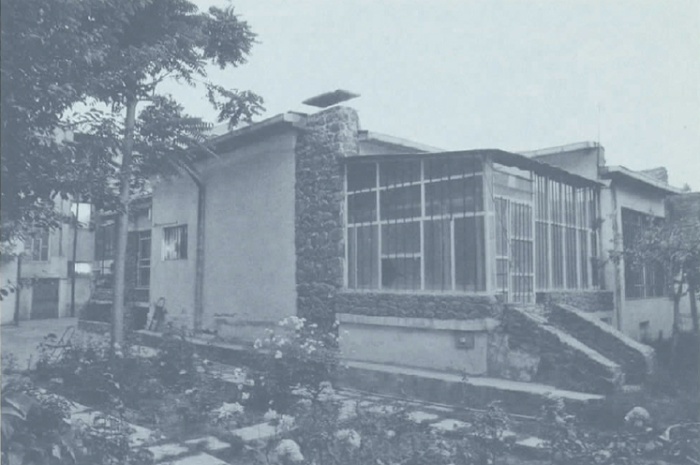
Tył dawnego Hotelu Jeden, Kabul, 2010.
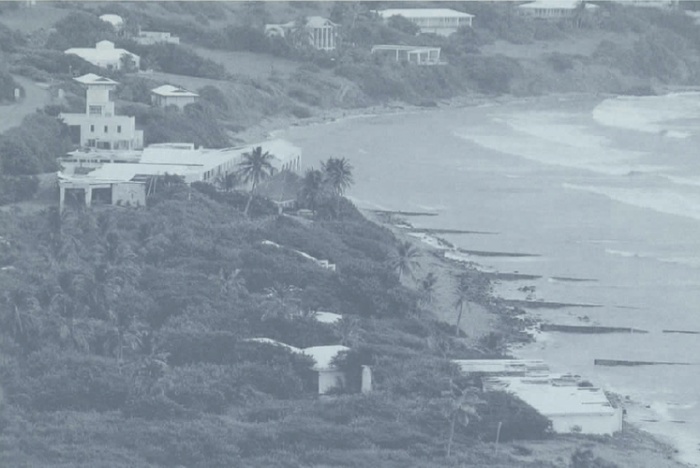
Na pierwszym planie opuszczony hotel Grapetree Bay, St. Croix, Wyspy Dziewicze, 2005.
Remarkably, Kippenberger brought attention to one more possibility of reacting to an invitation or, to put it in a better way, reacting to a non-invitation. For DOCUMENTA IX, he invited himself to the exhibition and produced a poster that announced his participation. In it, the logo of the exhibition and the dates of it were displayed, as well as a photograph of his work Untitled (Lamp) (1992), installed on the top of Walter De Maria’s Vertical Earth Kilometer (1977), in front of the Museum Fridericianum.
The business of inviting, of hosting, and of playing the role of a guest is a delicate one. One always has to negotiate between how one is expected to behave in somebody else’s space and the limits of an invitation. At the same time, one needs to define the thin line between one’s generosity and what one expects from the encounter with the others. I wonder whether all artists see it like that, at least the one who have engaged in a direct way with these activities. Did they expect something from the viewer? How complacent could they be? Would they ask something in return, attention to what they have to share, perhaps?
3.
Since I first learned about Alighiero Boetti and the hotel he had in Kabul, I was intrigued by the story. As I started to put the narrative together, I began encountering short tales about it, some published, some referred to by the artist’s acquaintances; I realized most of them were surrounded by mythic gossip and circulated as rumors. Nevertheless, they all mentioned more or less the same details: the One Hotel was a venture by Boetti and his local partner, Gholam Dastaghir. The hotel, where a “European breakfast” was served, was actually a house with a few subdivided rooms in Shar-e Naw district of Kabul, and probably had two entrances on different streets. It started in 1971, but the end date was always blurry, most of the time paired with the Soviet invasion of Afghanistan in 1979. Some accounts ended by saying that, at some point, the building that hosted the lodge was destroyed, thereby writing the last chapter of the story, which was echoed in a number of publications.9
The blurriness of the yarn kept me researching for some time before I was able to go to the site to try to understand Boetti’s role as a host. How did Boetti understand his position as a host, and furthermore, did that position, if at all, inform or influence the way he developed his artistic practice? If it is true that the One Hotel was never conceived as a work of art, but just as an essential part of Boetti’s daily life, I might not be mistaken to say that, as opposed to other artists of his generation, the Italian artist made his lifestyle and character very much part of his work, and as such, anything that permeated his days became background for his practice.
It is then possible to deduce that what Boetti was negotiating in his Afghan lodge was to be inviting while setting the rules of the game, a strategy that he concurrently implemented in the way he produced art as well as in the latter’s relationship to its beholders. In other words, the artist and his (sometimes casually requested) collaborators and accomplices engaged themselves in creating a number of works that were appealing, ensnaring, and enigmatic enough to captivate viewers but to make them conscious of their guest status. For, when conceiving a piece, an exhibition, or a text, one should be able to charm one’s guest into inhabiting the work just enough to have them question their possible roles while entering the work. This is the same kind of negotiation that one has to engage with when responding to any invitation, the elasticity of which both the guest and the host need to explore. In other words, what are the rules of this game, and how flexible can they be?
There is little at hand to truly make sense of the consequences of these shifts: from guest to host, and back to being a guest of one’s hosting condition. It is in these dynamics that the relations between guest and host and their respective attributes are strained to the point of reasonable doubt. When one shares a work with others, the best one can hope is for it to be inhabited, to be used, and misused. To inhabit a work, viewers have to let themselves go and, once inside, have to negotiate their positions in order to become the true guests of the piece.
I wonder whether this was at all the feeling when lodging at the One Hotel, knowing that it wasn’t conceived as an artwork; if the visitors, at least the ones who were conscious that the supposedly twin owners, Alighiero e Boetti, were, also an artist, understood this dichotomy and contradiction. I also wonder whether the hotel’s clients ever returned to it. Did they have good memories of their stay? Did the hotel give them what they expected – as any hotel should – or did they actually question their own status as guests in any way?
When an event like documenta is on the table, one wonders whether it is possible to create a work that would set up a story and, simultaneously, entwine the history of former editions of that event. What are the consequences of returning to a previously inhabited framework? Can one return to specific work that was previously shared in that same space? Can one dream of hosting that person’s participation? Can I inhabit someone else’s thought and then share it again? How can I share my relationship to an experience that seems to have been diluted over time and ask previous guests to come back? Could people inhabit a long-gone story? Could old and new guests share their ideas at the same table?
The building that hosted the One Hotel in Kabul was actually not destroyed; I have seen it. It’s freestanding, and beyond minor changes, it looks pretty much as it was when Boetti lived there.10 When I visited the site thirty-three years after it had closed, I wished – as in a missed rendezvous – that I could find a trace, another question mark next to Boetti’s name, that, by raising more questions, could offer more clues to whatever happened there as life simply went by.
If it is clear that all this is more questions than answers, at least I can hope, in a most honest way, that this text is a summons for what is to come, a call to check in, to dwell, and an invitation to feel at home in someone else’s thought and to stop and spend time in what others have to share. What are you bringing, dear reader, a bottle of wine or a bouquet of flowers?
BIO
Mario García Torres (born 1975 in Monclova) is a Mexican conceptual artist. He has used various media, including film, photography, sound, performance, and video as a means to create his art. His art explores the intricacies of the art system, mainly by looking at past events of conceptual arts history, targeting to show new perspectives on them and historiography. García Torres currently lives in Mexico City.
* Cover photo: Former entrance to Alighiero Boetti's One Hotel, Kabul, 2010.
[1] Szeemann’s documenta was surrounded by questions regarding his curatorial strategies, which were then unusual. He placed the work of a number of artists in specific thematic frames, a strategy that some artists didn’t feel comfortable with. “I do not wish to have my work used to illustrate misguided sociological principles or outmoded art historical categories,” began the latter that Robert Morris sent on May 6, 1972, to Giancarlo Politi, along with a larger statement signed by other invited documenta artists: Carl Andre, Hans Haacke, Donald Judd, Sol LeWitt, Barry Le Va, Dorothea Rockburn, Fred Sandback, Richard Serra, and Robert Smithson. The statement was accompanied by their withdrawal from the exhibition.
[2] Little is saved, at least in the documenta Archive, and not much more in the Archivo Boetti, Rome.
[3] A quick look at Szeemann’s invitation letters to artists reveals wide range of approaches, but most of them imply a previous personal contact and mostly confirmations of a spoken agreement. Though it does not mention the specific thematic frame for the work, the letter directed to Robert Morris asks the artist for a specific kinds of works; the one directed to the Spanish ZAJ group, on the other hand, simply – but, if looked at carefully, quite meaningfully – asks, “Would you be willing to take part in documenta 5?”
[4] Lavaro postale (permutazione) is a work composed of 720 envelopes, each with the same six postage stamps. The six stamps are arranged differently on each envelope; 720 equals the total number of arrangements possible with those six elements. After the stamps all were arranged, each envelope was posted from Turin in March 1972, and once received all were arranged to be shown.
[5] The brass plaque was first described in black and white in a letter from Boetti to Szeemann sent sometime in January 1972 and received in Kassel on the last day of the month. Apparently, this was response to a letter written on January 10 of that year from Kassel in which the Swiss curator had confirmed that Mappa was to be shown in documenta 5. Before closing the letter, Szeemann asks whether Boetti had any other ideas. In an undated note, probably sent later, from Boetti, he recognizes being indecisive: there is one Boetti who wants to show the tapestry work, but another who wants the brass plaque. All these documents are at the documenta Archive, Kassel.
[6] Daniel Buren, „Exhibitions of an Exhibition” [orig. 1972], in Achtung! Texte 1967–1991, ed. Gerti Fietzek and Gudrun Inboden (Dresden and Basel: Verlag der Kunst, 1995).
[7] Earlier that year, Ruppersberg had become a host in a different way. Around 1968, the artist opened Al’s Café, which he ran for three months. As Allan McCollum, who was in the place while it was functioning, points out, there were certain normalcy in the venture: “It was to function socially as a meeting place for friends, members of the art world, and anyone else who wanted to drop by. In direct opposition to what one might have expected from a young artist at the time, the decor was familiar to the point of strangeness: hyperfamiliar, you might say today.” Although everything seemed normal, the dishes were slightly off, with things that resembled food but were not. Ruppersberg, the cook, invited people to come in by using the format of an American diner, but once inside asked them to question the context; dishes weren’t normal, for instance, toast and leaves, pine cones and cookies. Around the same time, another type of hosting practice was established. In 1971, Gordon Matta-Clark and Carol Gooden opened a restaurant called Food. The establishment, in the SoHo district of New York, was managed and staffed by artists. It turned artists into hosts, even if they didn’t necessarily consider it their work, and having tables waited by artists made it, probably, a slightly different experience from a regular diner.
[8] As with Boetti’s, it’s uncertain whether the Works proposed by Ruppersberg were actually shown in documenta 5. The artist himself does not remember whether the proposed works match the ones mentioned in the catalogue. Correspondence from Ruppersberg to the author on May 7, 2011.
[9] According to recent accounts from Annemarie Sauzeau, the hotel actually only lasted for about six years, from 1971 to 1977. It closed two years before the Soviet invasion. See Sauzeau’s contribution to the series: Alighiero Boetti’s One Hotel/100 Notes – 100 Thoughts, no. 025 (Ostfildern: Hatje Cantz, 2011).
[10] It was actually fund a couple of years ago, by Tom Francis, then UN worker who happened to be as interested in the story as me, and who happened to be in Kabul. For a personal narrative of his discovery: Tom Francis, “One Star Is Enough to Make a Cosmos: Alighiero e Boetti and the One Hotel,” Bidoun, no. 19 (2009).



